A news release on Tuesday from the provincial government agency that collects and analyses health statistics showed the number of live births in the province in 2008 at 4905, the highest number “in any year since 1999”.
That’s true but more than a few people wondered why the Newfoundland and Labrador Centre for Health Information took the arbitrary year 1999 aside from the fact it is convenient to measure by decade. The other thing people wondered is why the agency would editorialise with the claim that “[t]his increase in the number of births is a positive step toward population growth for our province.”
 The analysts at NLCHI ought to know that the number of live births is just one factor in population trending. In addition, they would need to understand the cause for the increase, year over year, to see if this is actually something other than an anomaly in what has otherwise been a fairly steady decline in the number of live births to mothers whose residence is Newfoundland and Labrador.
The analysts at NLCHI ought to know that the number of live births is just one factor in population trending. In addition, they would need to understand the cause for the increase, year over year, to see if this is actually something other than an anomaly in what has otherwise been a fairly steady decline in the number of live births to mothers whose residence is Newfoundland and Labrador.
A look at NLCHI figures on live births going back to 1995 (chart, left) shows the long term trending.
The number of births has been declining for some time.
The number for 2008 is the highest number of births over the past decade, except for 1999. There were more than 5,000 live births that year.
The figures for 2006 and 2007 aren’t available, apparently. NLCHI didn’t release any data and only described the 2008 figures as being more than 300 higher than 2007. Statistics Canada figures cover the period up to 2006 and they are the same as the NLCHI figures.
It’s not hard to understand the declining number of births in the 1990s. Outmigration in the late 1990s took about 70,000 people out of the population, most of them in their child-bearing years.
The increase over the last four years is most likely due to a general improvement in the economy. The population continued to decline annually throughout the period and only showed an overall increase within the past year or so.
 A look at the crude birth rate (live births per thousand of population) gives another perspective. The birth rate declined precipitously as the population dropped among people of child-bearing age.
A look at the crude birth rate (live births per thousand of population) gives another perspective. The birth rate declined precipitously as the population dropped among people of child-bearing age.
After the major outmigration ended, the rate stabilized again and until the economy really started to surge the rate stayed relatively low.
One of the things to bear in mind when looking at these numbers is the inherent lag in births from time of conception. That sounds like a penetrating insight into the obvious but since some people are undoubtedly going to credit the government’s pro-natal policy for the increase the time lag has to be factored in.
Children born in late 2008 reflect parental decisions (even allowing for surprises) taken in the early part of the year. Children born in the first few months of 2008 were conceived before the bootie call announcement in September 2007. That time lag is the reason why the overall economic climate might have more of an impact on the decision to have children than a cash bounty of $1,000 for each live birth and $100 per month per child for the first year after birth.
 Statistics Update: The number crunching labradore picks up on the decline thingy. He points out that the number of births in the province has been declining every year since 1956 or so. There have been periodic upticks but the trend is decidedly downward.
Statistics Update: The number crunching labradore picks up on the decline thingy. He points out that the number of births in the province has been declining every year since 1956 or so. There have been periodic upticks but the trend is decidedly downward.
Skeptics update: To go with that, there’s a Bond Papers post from February that discusses some comments the finance minister made to Voice of the Cabinet Minister during polling season.
At that time, we were skeptical that the 4900 figure was real. We are still a little curious about the number and the timing of the release.
Halfway through 2008 and the preliminary figures showed everything on track to deliver about 4500. That’s an even more curious figure since the cash allocated by government for the program – which includes adoptions not accounted for in all the live birth numbers – works out to be 4500 children annually.
But as for 2008, even allowing for season variation and the nine month time lag, that would mean all the extra kiddies were hatched in the second half of the year. Makes you scratch your head a bit.
And if all that weren’t enough, consider this line from the provincial government’s main statistics agency:
The number of births has been trending downward for four decades because of declining fertility rates and, more recently, a decline in the number of women of child-bearing age.
That pretty much says it all. The population of people willing and able to have babies has been getting relatively smaller in this province. We’d have to go into a more detailed demographic breakout to see if there is an echo generation showing up. That’s the offspring of a previous boom suddenly showing up having children. It happened about 20-odd years ago as the children of baby boomers started reaching child-bearing age. We might be just at the leading edge of time when the baby-boomers’ grandchildren are starting to have babies.
As labradore noted at the time, since the population in child-bearing age has been going on, a baby crop of 4900 would mean that fewer people are having more children.
Sorta runs against what you’d expect.
-srbp-
